Leadership Management in the Smartphone Industry: The Nokia Case Study
VerifiedAdded on 2022/09/01
|22
|5621
|81
Report
AI Summary
This report examines the leadership and strategic decisions of Nokia, a prominent player in the early mobile phone industry. It explores the leadership styles employed, including charismatic, bureaucratic, and autocratic approaches, and analyzes how these styles influenced the company's trajectory. The report delves into the leadership of key figures like Jorma Ollila and evaluates the application of leadership theories such as the goal-path theory. It identifies critical failures in Nokia's leadership, such as the inability to adapt to technological changes, poor innovation, and strategic missteps in response to competitors like Apple and Android. The study also provides recommendations to overcome these challenges and rebuild the company's market position. The report concludes with a discussion of leadership strategies, including self-evaluation, effective communication, and proactive planning, to mitigate the negative impacts of leadership failures in the smartphone industry.

Leadership Management
Student’s Detail’s
Student’s Detail’s
Paraphrase This Document
Need a fresh take? Get an instant paraphrase of this document with our AI Paraphraser
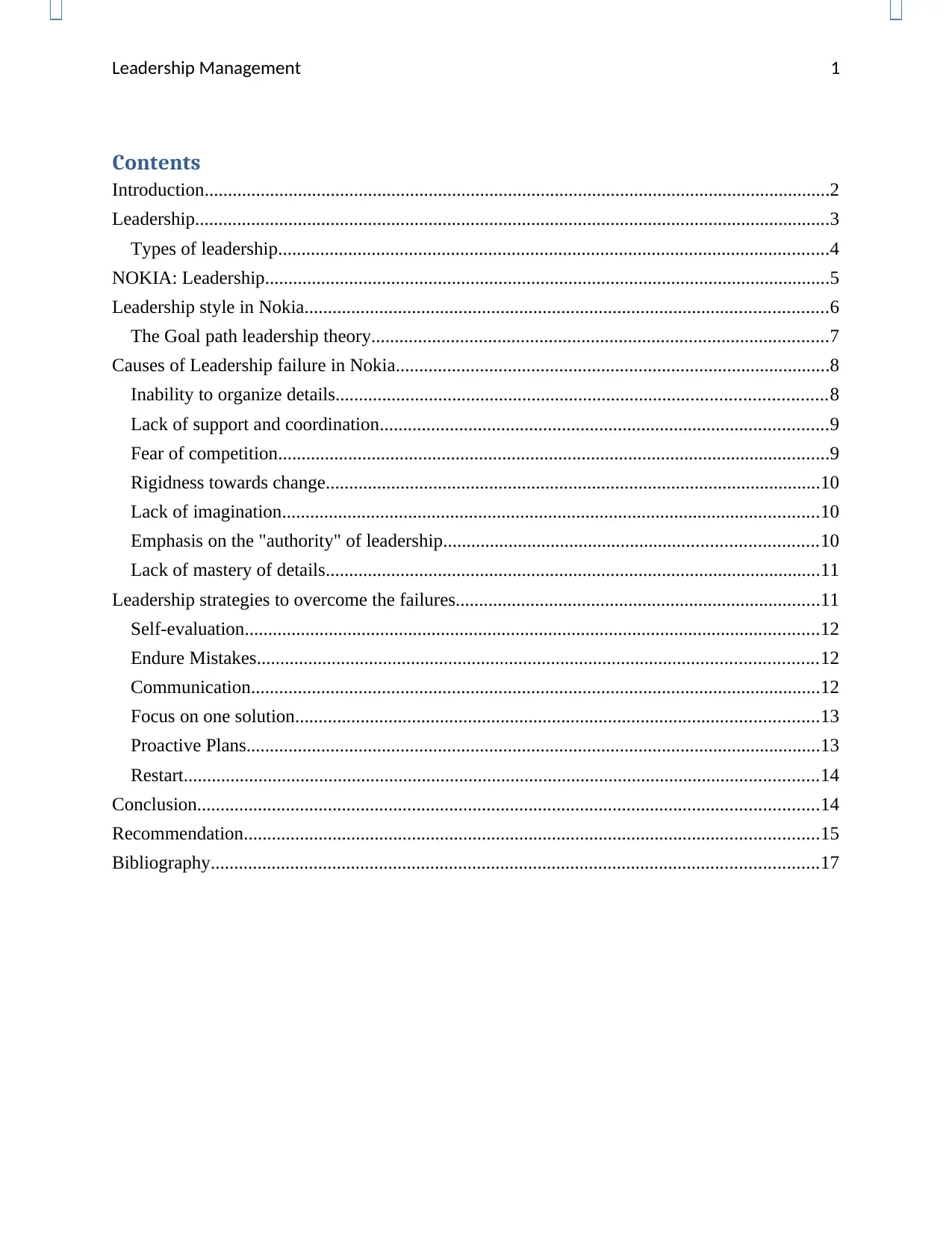
Leadership Management 1
Contents
Introduction......................................................................................................................................2
Leadership........................................................................................................................................3
Types of leadership......................................................................................................................4
NOKIA: Leadership.........................................................................................................................5
Leadership style in Nokia................................................................................................................6
The Goal path leadership theory..................................................................................................7
Causes of Leadership failure in Nokia.............................................................................................8
Inability to organize details.........................................................................................................8
Lack of support and coordination................................................................................................9
Fear of competition......................................................................................................................9
Rigidness towards change..........................................................................................................10
Lack of imagination...................................................................................................................10
Emphasis on the "authority" of leadership................................................................................10
Lack of mastery of details..........................................................................................................11
Leadership strategies to overcome the failures..............................................................................11
Self-evaluation...........................................................................................................................12
Endure Mistakes........................................................................................................................12
Communication..........................................................................................................................12
Focus on one solution................................................................................................................13
Proactive Plans...........................................................................................................................13
Restart........................................................................................................................................14
Conclusion.....................................................................................................................................14
Recommendation...........................................................................................................................15
Bibliography..................................................................................................................................17
Contents
Introduction......................................................................................................................................2
Leadership........................................................................................................................................3
Types of leadership......................................................................................................................4
NOKIA: Leadership.........................................................................................................................5
Leadership style in Nokia................................................................................................................6
The Goal path leadership theory..................................................................................................7
Causes of Leadership failure in Nokia.............................................................................................8
Inability to organize details.........................................................................................................8
Lack of support and coordination................................................................................................9
Fear of competition......................................................................................................................9
Rigidness towards change..........................................................................................................10
Lack of imagination...................................................................................................................10
Emphasis on the "authority" of leadership................................................................................10
Lack of mastery of details..........................................................................................................11
Leadership strategies to overcome the failures..............................................................................11
Self-evaluation...........................................................................................................................12
Endure Mistakes........................................................................................................................12
Communication..........................................................................................................................12
Focus on one solution................................................................................................................13
Proactive Plans...........................................................................................................................13
Restart........................................................................................................................................14
Conclusion.....................................................................................................................................14
Recommendation...........................................................................................................................15
Bibliography..................................................................................................................................17
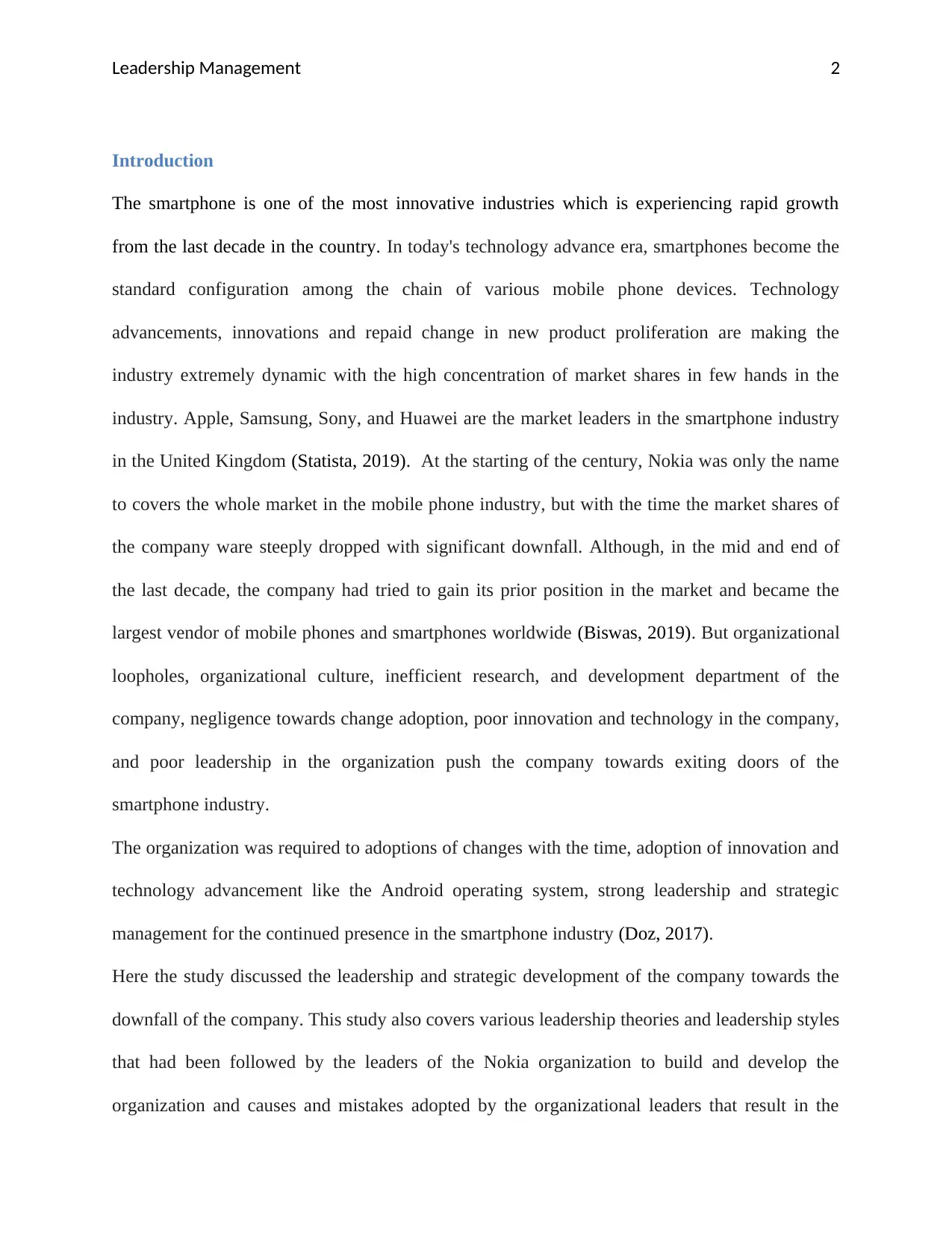
Leadership Management 2
Introduction
The smartphone is one of the most innovative industries which is experiencing rapid growth
from the last decade in the country. In today's technology advance era, smartphones become the
standard configuration among the chain of various mobile phone devices. Technology
advancements, innovations and repaid change in new product proliferation are making the
industry extremely dynamic with the high concentration of market shares in few hands in the
industry. Apple, Samsung, Sony, and Huawei are the market leaders in the smartphone industry
in the United Kingdom (Statista, 2019). At the starting of the century, Nokia was only the name
to covers the whole market in the mobile phone industry, but with the time the market shares of
the company ware steeply dropped with significant downfall. Although, in the mid and end of
the last decade, the company had tried to gain its prior position in the market and became the
largest vendor of mobile phones and smartphones worldwide (Biswas, 2019). But organizational
loopholes, organizational culture, inefficient research, and development department of the
company, negligence towards change adoption, poor innovation and technology in the company,
and poor leadership in the organization push the company towards exiting doors of the
smartphone industry.
The organization was required to adoptions of changes with the time, adoption of innovation and
technology advancement like the Android operating system, strong leadership and strategic
management for the continued presence in the smartphone industry (Doz, 2017).
Here the study discussed the leadership and strategic development of the company towards the
downfall of the company. This study also covers various leadership theories and leadership styles
that had been followed by the leaders of the Nokia organization to build and develop the
organization and causes and mistakes adopted by the organizational leaders that result in the
Introduction
The smartphone is one of the most innovative industries which is experiencing rapid growth
from the last decade in the country. In today's technology advance era, smartphones become the
standard configuration among the chain of various mobile phone devices. Technology
advancements, innovations and repaid change in new product proliferation are making the
industry extremely dynamic with the high concentration of market shares in few hands in the
industry. Apple, Samsung, Sony, and Huawei are the market leaders in the smartphone industry
in the United Kingdom (Statista, 2019). At the starting of the century, Nokia was only the name
to covers the whole market in the mobile phone industry, but with the time the market shares of
the company ware steeply dropped with significant downfall. Although, in the mid and end of
the last decade, the company had tried to gain its prior position in the market and became the
largest vendor of mobile phones and smartphones worldwide (Biswas, 2019). But organizational
loopholes, organizational culture, inefficient research, and development department of the
company, negligence towards change adoption, poor innovation and technology in the company,
and poor leadership in the organization push the company towards exiting doors of the
smartphone industry.
The organization was required to adoptions of changes with the time, adoption of innovation and
technology advancement like the Android operating system, strong leadership and strategic
management for the continued presence in the smartphone industry (Doz, 2017).
Here the study discussed the leadership and strategic development of the company towards the
downfall of the company. This study also covers various leadership theories and leadership styles
that had been followed by the leaders of the Nokia organization to build and develop the
organization and causes and mistakes adopted by the organizational leaders that result in the
⊘ This is a preview!⊘
Do you want full access?
Subscribe today to unlock all pages.

Trusted by 1+ million students worldwide
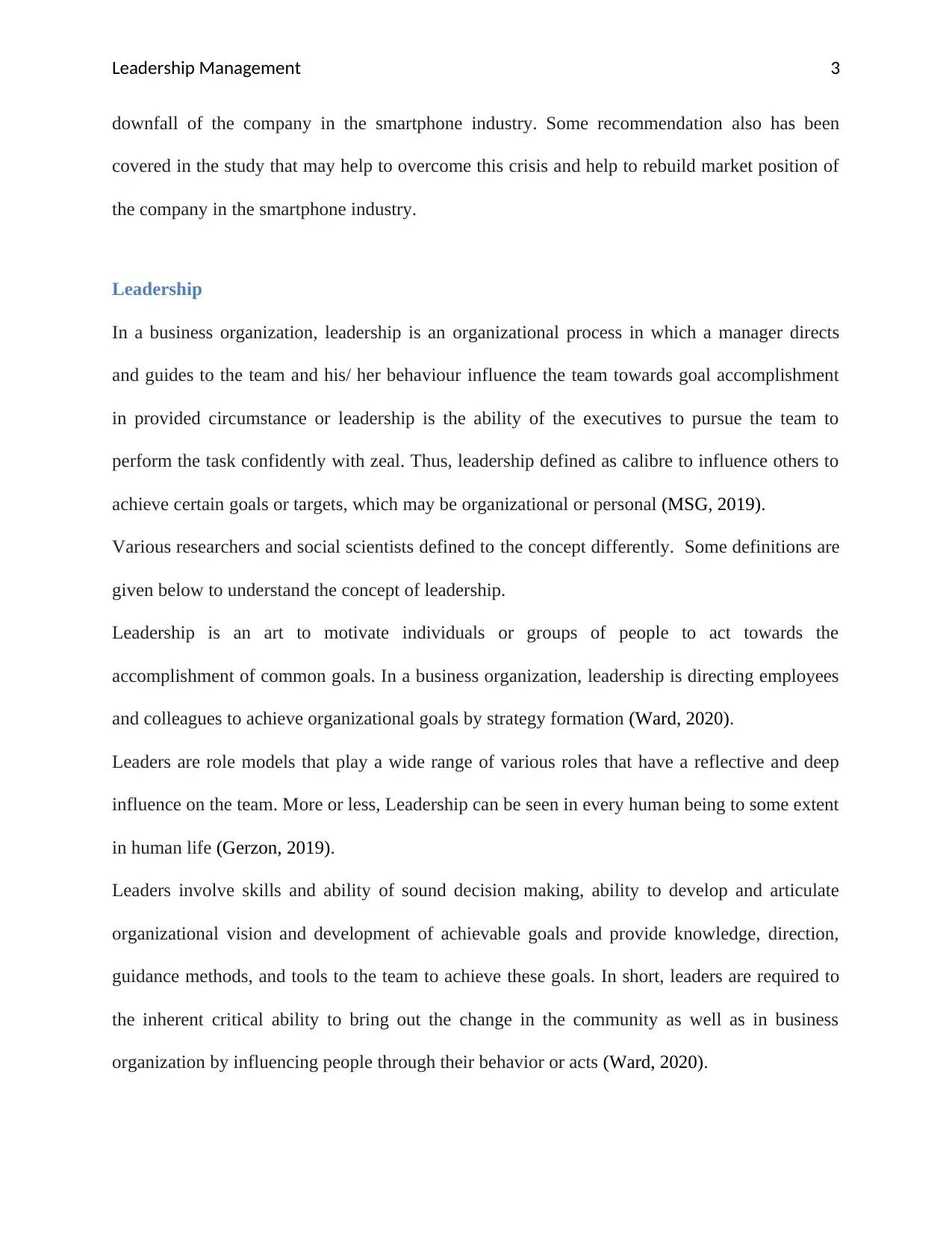
Leadership Management 3
downfall of the company in the smartphone industry. Some recommendation also has been
covered in the study that may help to overcome this crisis and help to rebuild market position of
the company in the smartphone industry.
Leadership
In a business organization, leadership is an organizational process in which a manager directs
and guides to the team and his/ her behaviour influence the team towards goal accomplishment
in provided circumstance or leadership is the ability of the executives to pursue the team to
perform the task confidently with zeal. Thus, leadership defined as calibre to influence others to
achieve certain goals or targets, which may be organizational or personal (MSG, 2019).
Various researchers and social scientists defined to the concept differently. Some definitions are
given below to understand the concept of leadership.
Leadership is an art to motivate individuals or groups of people to act towards the
accomplishment of common goals. In a business organization, leadership is directing employees
and colleagues to achieve organizational goals by strategy formation (Ward, 2020).
Leaders are role models that play a wide range of various roles that have a reflective and deep
influence on the team. More or less, Leadership can be seen in every human being to some extent
in human life (Gerzon, 2019).
Leaders involve skills and ability of sound decision making, ability to develop and articulate
organizational vision and development of achievable goals and provide knowledge, direction,
guidance methods, and tools to the team to achieve these goals. In short, leaders are required to
the inherent critical ability to bring out the change in the community as well as in business
organization by influencing people through their behavior or acts (Ward, 2020).
downfall of the company in the smartphone industry. Some recommendation also has been
covered in the study that may help to overcome this crisis and help to rebuild market position of
the company in the smartphone industry.
Leadership
In a business organization, leadership is an organizational process in which a manager directs
and guides to the team and his/ her behaviour influence the team towards goal accomplishment
in provided circumstance or leadership is the ability of the executives to pursue the team to
perform the task confidently with zeal. Thus, leadership defined as calibre to influence others to
achieve certain goals or targets, which may be organizational or personal (MSG, 2019).
Various researchers and social scientists defined to the concept differently. Some definitions are
given below to understand the concept of leadership.
Leadership is an art to motivate individuals or groups of people to act towards the
accomplishment of common goals. In a business organization, leadership is directing employees
and colleagues to achieve organizational goals by strategy formation (Ward, 2020).
Leaders are role models that play a wide range of various roles that have a reflective and deep
influence on the team. More or less, Leadership can be seen in every human being to some extent
in human life (Gerzon, 2019).
Leaders involve skills and ability of sound decision making, ability to develop and articulate
organizational vision and development of achievable goals and provide knowledge, direction,
guidance methods, and tools to the team to achieve these goals. In short, leaders are required to
the inherent critical ability to bring out the change in the community as well as in business
organization by influencing people through their behavior or acts (Ward, 2020).
Paraphrase This Document
Need a fresh take? Get an instant paraphrase of this document with our AI Paraphraser
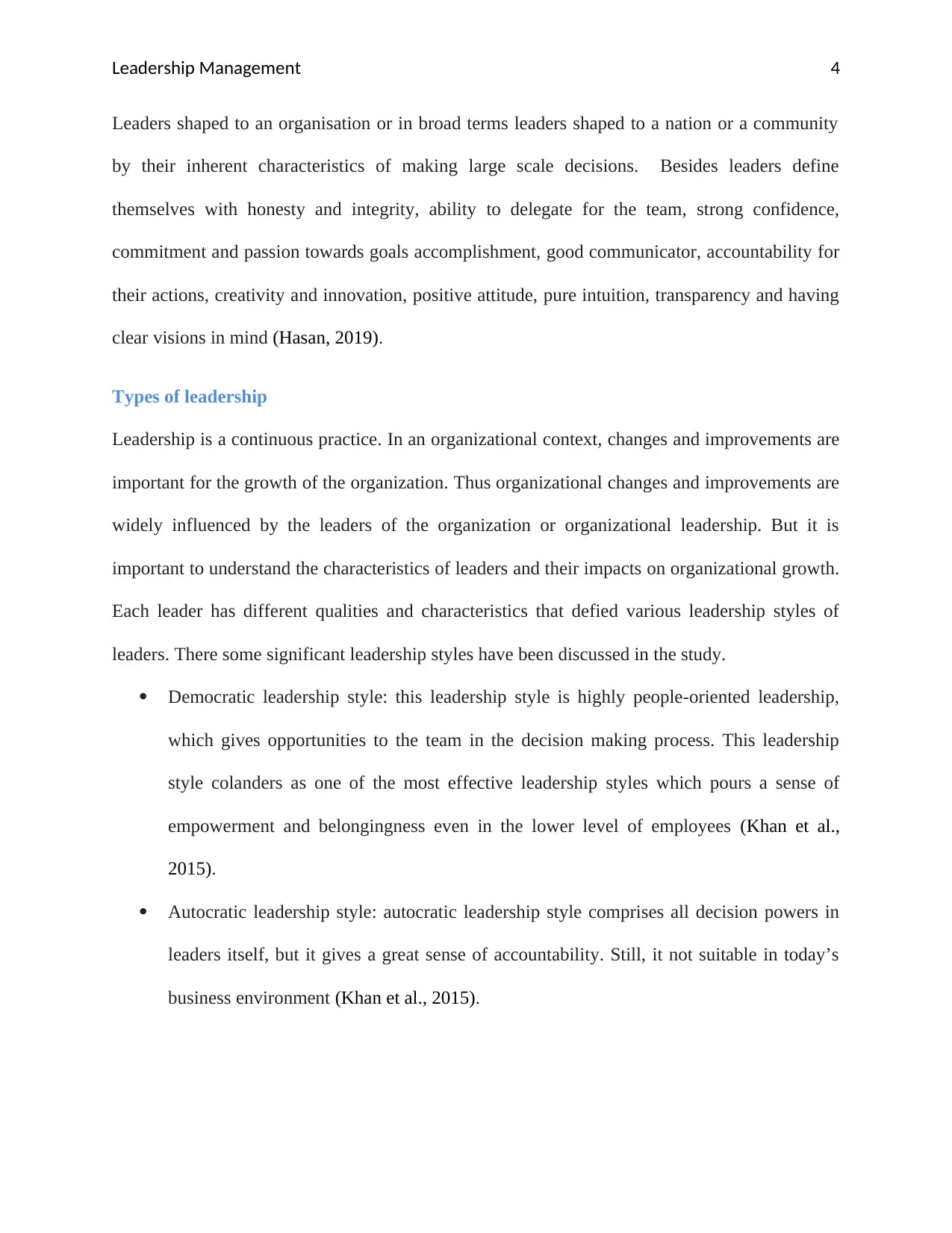
Leadership Management 4
Leaders shaped to an organisation or in broad terms leaders shaped to a nation or a community
by their inherent characteristics of making large scale decisions. Besides leaders define
themselves with honesty and integrity, ability to delegate for the team, strong confidence,
commitment and passion towards goals accomplishment, good communicator, accountability for
their actions, creativity and innovation, positive attitude, pure intuition, transparency and having
clear visions in mind (Hasan, 2019).
Types of leadership
Leadership is a continuous practice. In an organizational context, changes and improvements are
important for the growth of the organization. Thus organizational changes and improvements are
widely influenced by the leaders of the organization or organizational leadership. But it is
important to understand the characteristics of leaders and their impacts on organizational growth.
Each leader has different qualities and characteristics that defied various leadership styles of
leaders. There some significant leadership styles have been discussed in the study.
Democratic leadership style: this leadership style is highly people-oriented leadership,
which gives opportunities to the team in the decision making process. This leadership
style colanders as one of the most effective leadership styles which pours a sense of
empowerment and belongingness even in the lower level of employees (Khan et al.,
2015).
Autocratic leadership style: autocratic leadership style comprises all decision powers in
leaders itself, but it gives a great sense of accountability. Still, it not suitable in today’s
business environment (Khan et al., 2015).
Leaders shaped to an organisation or in broad terms leaders shaped to a nation or a community
by their inherent characteristics of making large scale decisions. Besides leaders define
themselves with honesty and integrity, ability to delegate for the team, strong confidence,
commitment and passion towards goals accomplishment, good communicator, accountability for
their actions, creativity and innovation, positive attitude, pure intuition, transparency and having
clear visions in mind (Hasan, 2019).
Types of leadership
Leadership is a continuous practice. In an organizational context, changes and improvements are
important for the growth of the organization. Thus organizational changes and improvements are
widely influenced by the leaders of the organization or organizational leadership. But it is
important to understand the characteristics of leaders and their impacts on organizational growth.
Each leader has different qualities and characteristics that defied various leadership styles of
leaders. There some significant leadership styles have been discussed in the study.
Democratic leadership style: this leadership style is highly people-oriented leadership,
which gives opportunities to the team in the decision making process. This leadership
style colanders as one of the most effective leadership styles which pours a sense of
empowerment and belongingness even in the lower level of employees (Khan et al.,
2015).
Autocratic leadership style: autocratic leadership style comprises all decision powers in
leaders itself, but it gives a great sense of accountability. Still, it not suitable in today’s
business environment (Khan et al., 2015).
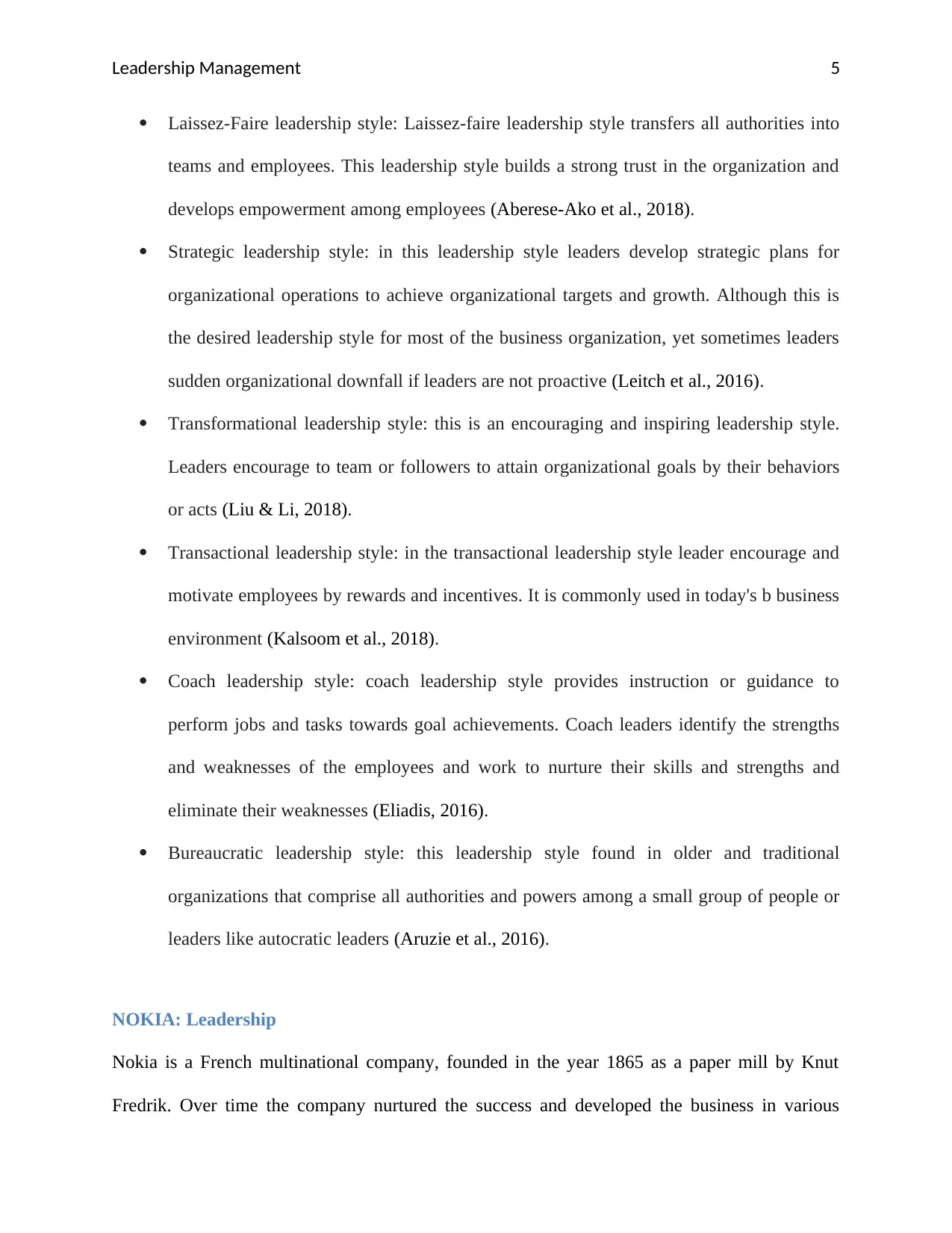
Leadership Management 5
Laissez-Faire leadership style: Laissez-faire leadership style transfers all authorities into
teams and employees. This leadership style builds a strong trust in the organization and
develops empowerment among employees (Aberese-Ako et al., 2018).
Strategic leadership style: in this leadership style leaders develop strategic plans for
organizational operations to achieve organizational targets and growth. Although this is
the desired leadership style for most of the business organization, yet sometimes leaders
sudden organizational downfall if leaders are not proactive (Leitch et al., 2016).
Transformational leadership style: this is an encouraging and inspiring leadership style.
Leaders encourage to team or followers to attain organizational goals by their behaviors
or acts (Liu & Li, 2018).
Transactional leadership style: in the transactional leadership style leader encourage and
motivate employees by rewards and incentives. It is commonly used in today's b business
environment (Kalsoom et al., 2018).
Coach leadership style: coach leadership style provides instruction or guidance to
perform jobs and tasks towards goal achievements. Coach leaders identify the strengths
and weaknesses of the employees and work to nurture their skills and strengths and
eliminate their weaknesses (Eliadis, 2016).
Bureaucratic leadership style: this leadership style found in older and traditional
organizations that comprise all authorities and powers among a small group of people or
leaders like autocratic leaders (Aruzie et al., 2016).
NOKIA: Leadership
Nokia is a French multinational company, founded in the year 1865 as a paper mill by Knut
Fredrik. Over time the company nurtured the success and developed the business in various
Laissez-Faire leadership style: Laissez-faire leadership style transfers all authorities into
teams and employees. This leadership style builds a strong trust in the organization and
develops empowerment among employees (Aberese-Ako et al., 2018).
Strategic leadership style: in this leadership style leaders develop strategic plans for
organizational operations to achieve organizational targets and growth. Although this is
the desired leadership style for most of the business organization, yet sometimes leaders
sudden organizational downfall if leaders are not proactive (Leitch et al., 2016).
Transformational leadership style: this is an encouraging and inspiring leadership style.
Leaders encourage to team or followers to attain organizational goals by their behaviors
or acts (Liu & Li, 2018).
Transactional leadership style: in the transactional leadership style leader encourage and
motivate employees by rewards and incentives. It is commonly used in today's b business
environment (Kalsoom et al., 2018).
Coach leadership style: coach leadership style provides instruction or guidance to
perform jobs and tasks towards goal achievements. Coach leaders identify the strengths
and weaknesses of the employees and work to nurture their skills and strengths and
eliminate their weaknesses (Eliadis, 2016).
Bureaucratic leadership style: this leadership style found in older and traditional
organizations that comprise all authorities and powers among a small group of people or
leaders like autocratic leaders (Aruzie et al., 2016).
NOKIA: Leadership
Nokia is a French multinational company, founded in the year 1865 as a paper mill by Knut
Fredrik. Over time the company nurtured the success and developed the business in various
⊘ This is a preview!⊘
Do you want full access?
Subscribe today to unlock all pages.

Trusted by 1+ million students worldwide
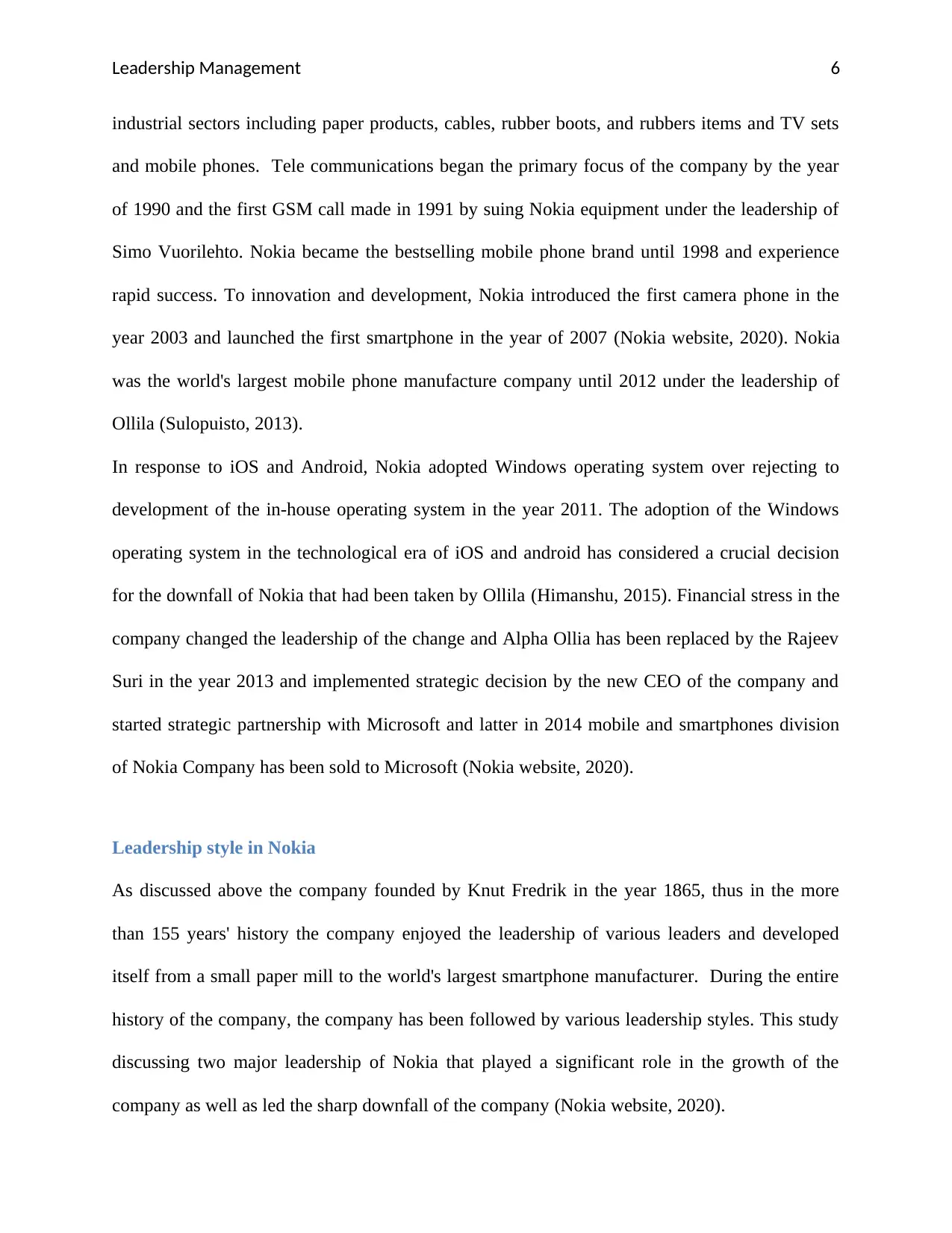
Leadership Management 6
industrial sectors including paper products, cables, rubber boots, and rubbers items and TV sets
and mobile phones. Tele communications began the primary focus of the company by the year
of 1990 and the first GSM call made in 1991 by suing Nokia equipment under the leadership of
Simo Vuorilehto. Nokia became the bestselling mobile phone brand until 1998 and experience
rapid success. To innovation and development, Nokia introduced the first camera phone in the
year 2003 and launched the first smartphone in the year of 2007 (Nokia website, 2020). Nokia
was the world's largest mobile phone manufacture company until 2012 under the leadership of
Ollila (Sulopuisto, 2013).
In response to iOS and Android, Nokia adopted Windows operating system over rejecting to
development of the in-house operating system in the year 2011. The adoption of the Windows
operating system in the technological era of iOS and android has considered a crucial decision
for the downfall of Nokia that had been taken by Ollila (Himanshu, 2015). Financial stress in the
company changed the leadership of the change and Alpha Ollia has been replaced by the Rajeev
Suri in the year 2013 and implemented strategic decision by the new CEO of the company and
started strategic partnership with Microsoft and latter in 2014 mobile and smartphones division
of Nokia Company has been sold to Microsoft (Nokia website, 2020).
Leadership style in Nokia
As discussed above the company founded by Knut Fredrik in the year 1865, thus in the more
than 155 years' history the company enjoyed the leadership of various leaders and developed
itself from a small paper mill to the world's largest smartphone manufacturer. During the entire
history of the company, the company has been followed by various leadership styles. This study
discussing two major leadership of Nokia that played a significant role in the growth of the
company as well as led the sharp downfall of the company (Nokia website, 2020).
industrial sectors including paper products, cables, rubber boots, and rubbers items and TV sets
and mobile phones. Tele communications began the primary focus of the company by the year
of 1990 and the first GSM call made in 1991 by suing Nokia equipment under the leadership of
Simo Vuorilehto. Nokia became the bestselling mobile phone brand until 1998 and experience
rapid success. To innovation and development, Nokia introduced the first camera phone in the
year 2003 and launched the first smartphone in the year of 2007 (Nokia website, 2020). Nokia
was the world's largest mobile phone manufacture company until 2012 under the leadership of
Ollila (Sulopuisto, 2013).
In response to iOS and Android, Nokia adopted Windows operating system over rejecting to
development of the in-house operating system in the year 2011. The adoption of the Windows
operating system in the technological era of iOS and android has considered a crucial decision
for the downfall of Nokia that had been taken by Ollila (Himanshu, 2015). Financial stress in the
company changed the leadership of the change and Alpha Ollia has been replaced by the Rajeev
Suri in the year 2013 and implemented strategic decision by the new CEO of the company and
started strategic partnership with Microsoft and latter in 2014 mobile and smartphones division
of Nokia Company has been sold to Microsoft (Nokia website, 2020).
Leadership style in Nokia
As discussed above the company founded by Knut Fredrik in the year 1865, thus in the more
than 155 years' history the company enjoyed the leadership of various leaders and developed
itself from a small paper mill to the world's largest smartphone manufacturer. During the entire
history of the company, the company has been followed by various leadership styles. This study
discussing two major leadership of Nokia that played a significant role in the growth of the
company as well as led the sharp downfall of the company (Nokia website, 2020).
Paraphrase This Document
Need a fresh take? Get an instant paraphrase of this document with our AI Paraphraser
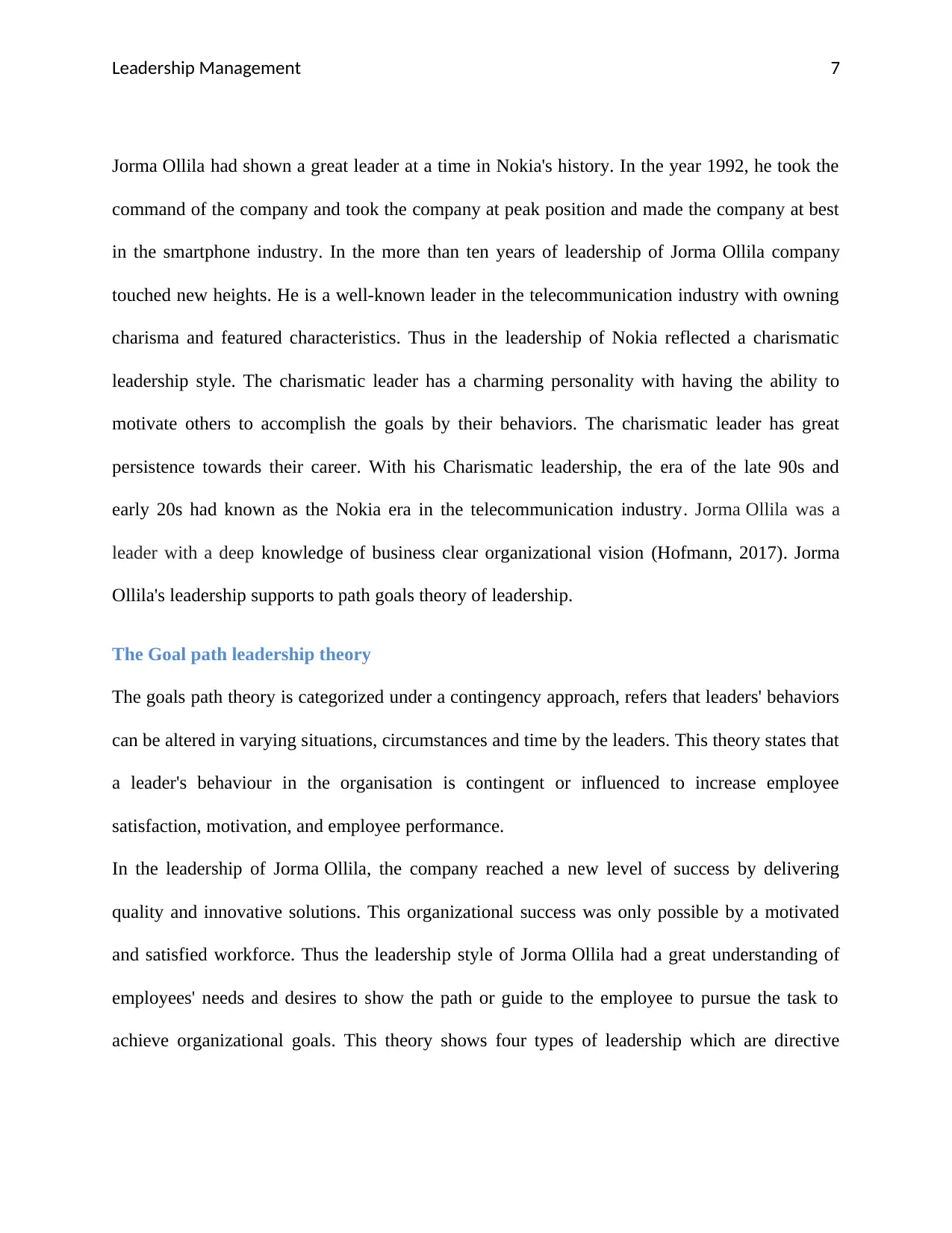
Leadership Management 7
Jorma Ollila had shown a great leader at a time in Nokia's history. In the year 1992, he took the
command of the company and took the company at peak position and made the company at best
in the smartphone industry. In the more than ten years of leadership of Jorma Ollila company
touched new heights. He is a well-known leader in the telecommunication industry with owning
charisma and featured characteristics. Thus in the leadership of Nokia reflected a charismatic
leadership style. The charismatic leader has a charming personality with having the ability to
motivate others to accomplish the goals by their behaviors. The charismatic leader has great
persistence towards their career. With his Charismatic leadership, the era of the late 90s and
early 20s had known as the Nokia era in the telecommunication industry. Jorma Ollila was a
leader with a deep knowledge of business clear organizational vision (Hofmann, 2017). Jorma
Ollila's leadership supports to path goals theory of leadership.
The Goal path leadership theory
The goals path theory is categorized under a contingency approach, refers that leaders' behaviors
can be altered in varying situations, circumstances and time by the leaders. This theory states that
a leader's behaviour in the organisation is contingent or influenced to increase employee
satisfaction, motivation, and employee performance.
In the leadership of Jorma Ollila, the company reached a new level of success by delivering
quality and innovative solutions. This organizational success was only possible by a motivated
and satisfied workforce. Thus the leadership style of Jorma Ollila had a great understanding of
employees' needs and desires to show the path or guide to the employee to pursue the task to
achieve organizational goals. This theory shows four types of leadership which are directive
Jorma Ollila had shown a great leader at a time in Nokia's history. In the year 1992, he took the
command of the company and took the company at peak position and made the company at best
in the smartphone industry. In the more than ten years of leadership of Jorma Ollila company
touched new heights. He is a well-known leader in the telecommunication industry with owning
charisma and featured characteristics. Thus in the leadership of Nokia reflected a charismatic
leadership style. The charismatic leader has a charming personality with having the ability to
motivate others to accomplish the goals by their behaviors. The charismatic leader has great
persistence towards their career. With his Charismatic leadership, the era of the late 90s and
early 20s had known as the Nokia era in the telecommunication industry. Jorma Ollila was a
leader with a deep knowledge of business clear organizational vision (Hofmann, 2017). Jorma
Ollila's leadership supports to path goals theory of leadership.
The Goal path leadership theory
The goals path theory is categorized under a contingency approach, refers that leaders' behaviors
can be altered in varying situations, circumstances and time by the leaders. This theory states that
a leader's behaviour in the organisation is contingent or influenced to increase employee
satisfaction, motivation, and employee performance.
In the leadership of Jorma Ollila, the company reached a new level of success by delivering
quality and innovative solutions. This organizational success was only possible by a motivated
and satisfied workforce. Thus the leadership style of Jorma Ollila had a great understanding of
employees' needs and desires to show the path or guide to the employee to pursue the task to
achieve organizational goals. This theory shows four types of leadership which are directive
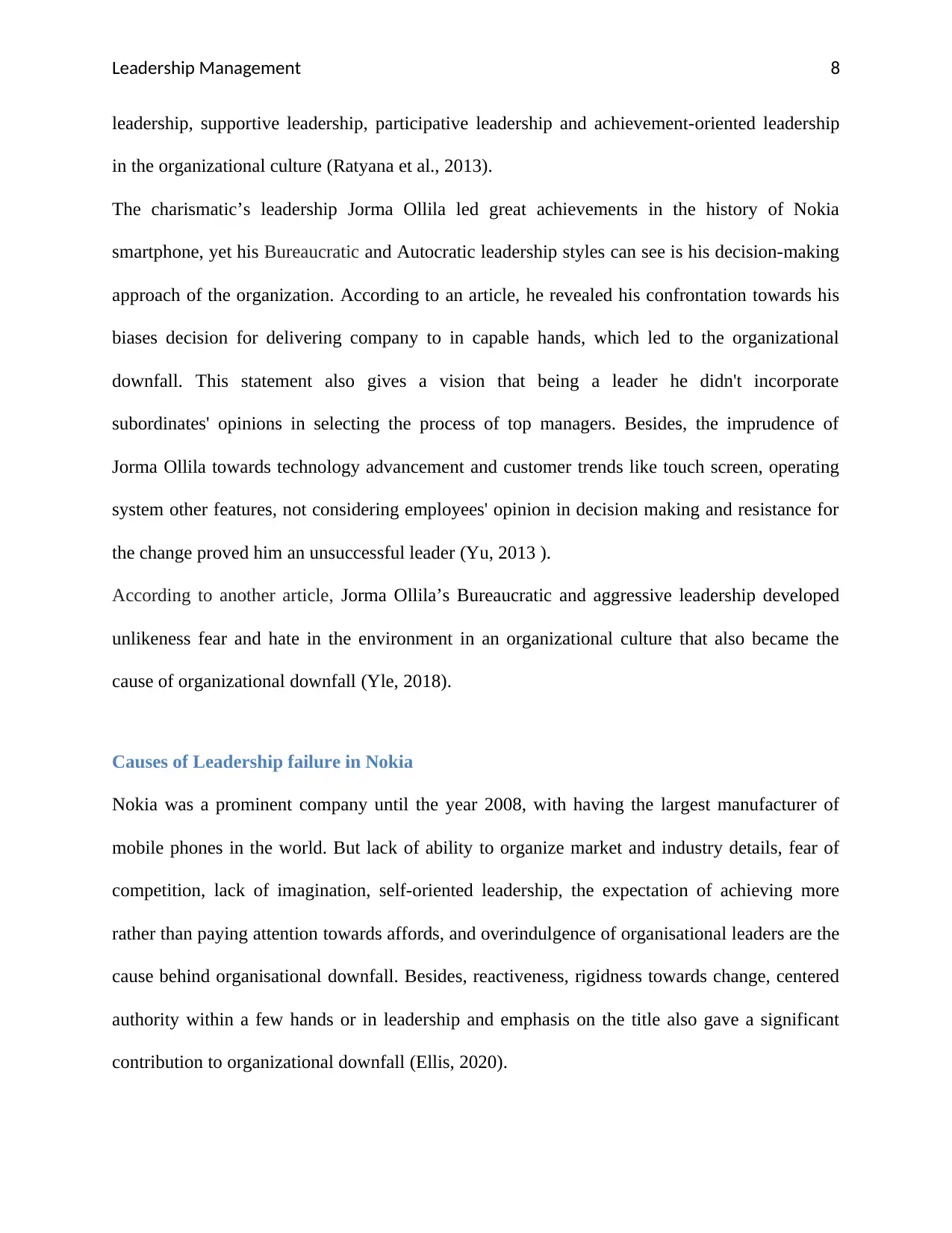
Leadership Management 8
leadership, supportive leadership, participative leadership and achievement-oriented leadership
in the organizational culture (Ratyana et al., 2013).
The charismatic’s leadership Jorma Ollila led great achievements in the history of Nokia
smartphone, yet his Bureaucratic and Autocratic leadership styles can see is his decision-making
approach of the organization. According to an article, he revealed his confrontation towards his
biases decision for delivering company to in capable hands, which led to the organizational
downfall. This statement also gives a vision that being a leader he didn't incorporate
subordinates' opinions in selecting the process of top managers. Besides, the imprudence of
Jorma Ollila towards technology advancement and customer trends like touch screen, operating
system other features, not considering employees' opinion in decision making and resistance for
the change proved him an unsuccessful leader (Yu, 2013 ).
According to another article, Jorma Ollila’s Bureaucratic and aggressive leadership developed
unlikeness fear and hate in the environment in an organizational culture that also became the
cause of organizational downfall (Yle, 2018).
Causes of Leadership failure in Nokia
Nokia was a prominent company until the year 2008, with having the largest manufacturer of
mobile phones in the world. But lack of ability to organize market and industry details, fear of
competition, lack of imagination, self-oriented leadership, the expectation of achieving more
rather than paying attention towards affords, and overindulgence of organisational leaders are the
cause behind organisational downfall. Besides, reactiveness, rigidness towards change, centered
authority within a few hands or in leadership and emphasis on the title also gave a significant
contribution to organizational downfall (Ellis, 2020).
leadership, supportive leadership, participative leadership and achievement-oriented leadership
in the organizational culture (Ratyana et al., 2013).
The charismatic’s leadership Jorma Ollila led great achievements in the history of Nokia
smartphone, yet his Bureaucratic and Autocratic leadership styles can see is his decision-making
approach of the organization. According to an article, he revealed his confrontation towards his
biases decision for delivering company to in capable hands, which led to the organizational
downfall. This statement also gives a vision that being a leader he didn't incorporate
subordinates' opinions in selecting the process of top managers. Besides, the imprudence of
Jorma Ollila towards technology advancement and customer trends like touch screen, operating
system other features, not considering employees' opinion in decision making and resistance for
the change proved him an unsuccessful leader (Yu, 2013 ).
According to another article, Jorma Ollila’s Bureaucratic and aggressive leadership developed
unlikeness fear and hate in the environment in an organizational culture that also became the
cause of organizational downfall (Yle, 2018).
Causes of Leadership failure in Nokia
Nokia was a prominent company until the year 2008, with having the largest manufacturer of
mobile phones in the world. But lack of ability to organize market and industry details, fear of
competition, lack of imagination, self-oriented leadership, the expectation of achieving more
rather than paying attention towards affords, and overindulgence of organisational leaders are the
cause behind organisational downfall. Besides, reactiveness, rigidness towards change, centered
authority within a few hands or in leadership and emphasis on the title also gave a significant
contribution to organizational downfall (Ellis, 2020).
⊘ This is a preview!⊘
Do you want full access?
Subscribe today to unlock all pages.

Trusted by 1+ million students worldwide
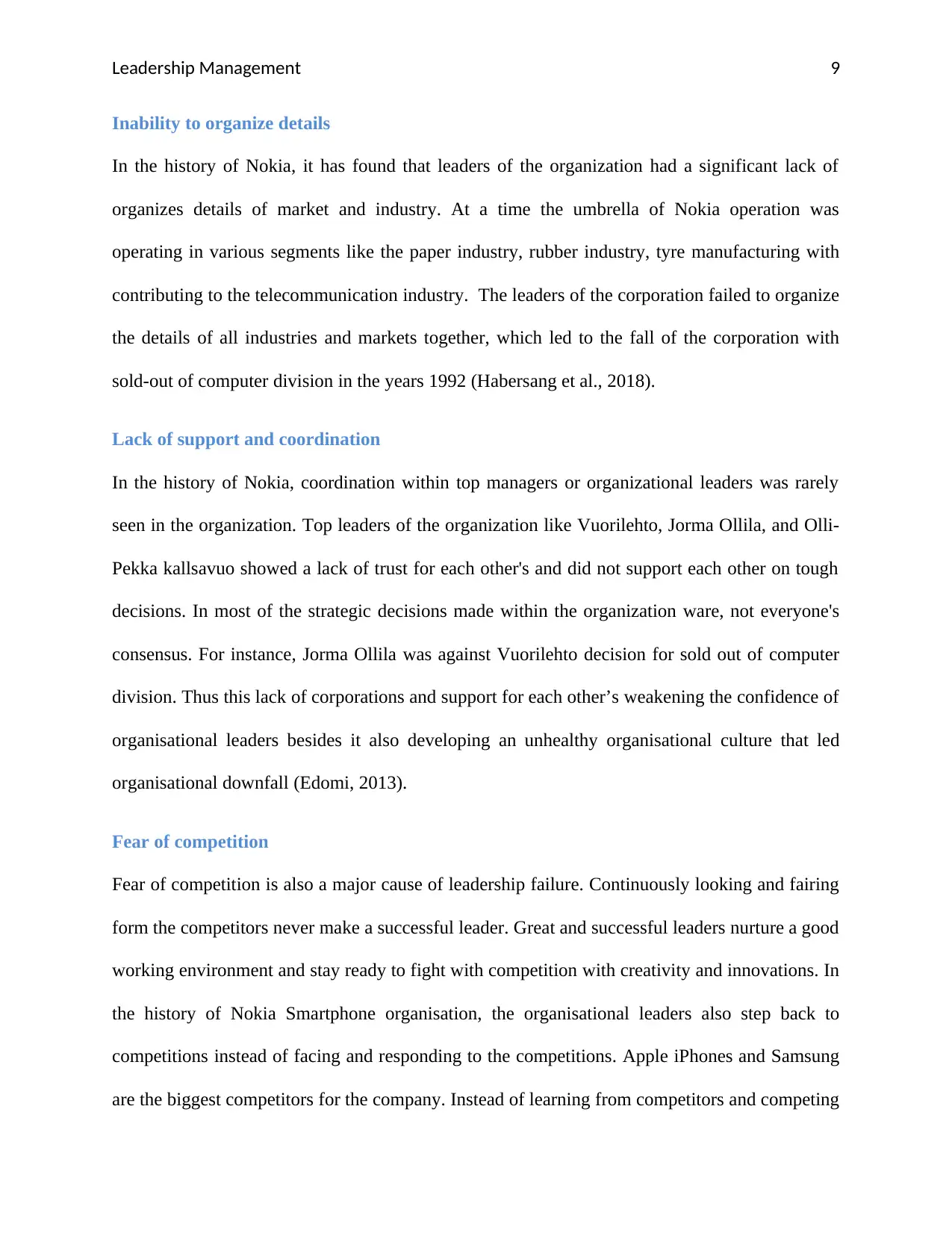
Leadership Management 9
Inability to organize details
In the history of Nokia, it has found that leaders of the organization had a significant lack of
organizes details of market and industry. At a time the umbrella of Nokia operation was
operating in various segments like the paper industry, rubber industry, tyre manufacturing with
contributing to the telecommunication industry. The leaders of the corporation failed to organize
the details of all industries and markets together, which led to the fall of the corporation with
sold-out of computer division in the years 1992 (Habersang et al., 2018).
Lack of support and coordination
In the history of Nokia, coordination within top managers or organizational leaders was rarely
seen in the organization. Top leaders of the organization like Vuorilehto, Jorma Ollila, and Olli-
Pekka kallsavuo showed a lack of trust for each other's and did not support each other on tough
decisions. In most of the strategic decisions made within the organization ware, not everyone's
consensus. For instance, Jorma Ollila was against Vuorilehto decision for sold out of computer
division. Thus this lack of corporations and support for each other’s weakening the confidence of
organisational leaders besides it also developing an unhealthy organisational culture that led
organisational downfall (Edomi, 2013).
Fear of competition
Fear of competition is also a major cause of leadership failure. Continuously looking and fairing
form the competitors never make a successful leader. Great and successful leaders nurture a good
working environment and stay ready to fight with competition with creativity and innovations. In
the history of Nokia Smartphone organisation, the organisational leaders also step back to
competitions instead of facing and responding to the competitions. Apple iPhones and Samsung
are the biggest competitors for the company. Instead of learning from competitors and competing
Inability to organize details
In the history of Nokia, it has found that leaders of the organization had a significant lack of
organizes details of market and industry. At a time the umbrella of Nokia operation was
operating in various segments like the paper industry, rubber industry, tyre manufacturing with
contributing to the telecommunication industry. The leaders of the corporation failed to organize
the details of all industries and markets together, which led to the fall of the corporation with
sold-out of computer division in the years 1992 (Habersang et al., 2018).
Lack of support and coordination
In the history of Nokia, coordination within top managers or organizational leaders was rarely
seen in the organization. Top leaders of the organization like Vuorilehto, Jorma Ollila, and Olli-
Pekka kallsavuo showed a lack of trust for each other's and did not support each other on tough
decisions. In most of the strategic decisions made within the organization ware, not everyone's
consensus. For instance, Jorma Ollila was against Vuorilehto decision for sold out of computer
division. Thus this lack of corporations and support for each other’s weakening the confidence of
organisational leaders besides it also developing an unhealthy organisational culture that led
organisational downfall (Edomi, 2013).
Fear of competition
Fear of competition is also a major cause of leadership failure. Continuously looking and fairing
form the competitors never make a successful leader. Great and successful leaders nurture a good
working environment and stay ready to fight with competition with creativity and innovations. In
the history of Nokia Smartphone organisation, the organisational leaders also step back to
competitions instead of facing and responding to the competitions. Apple iPhones and Samsung
are the biggest competitors for the company. Instead of learning from competitors and competing
Paraphrase This Document
Need a fresh take? Get an instant paraphrase of this document with our AI Paraphraser
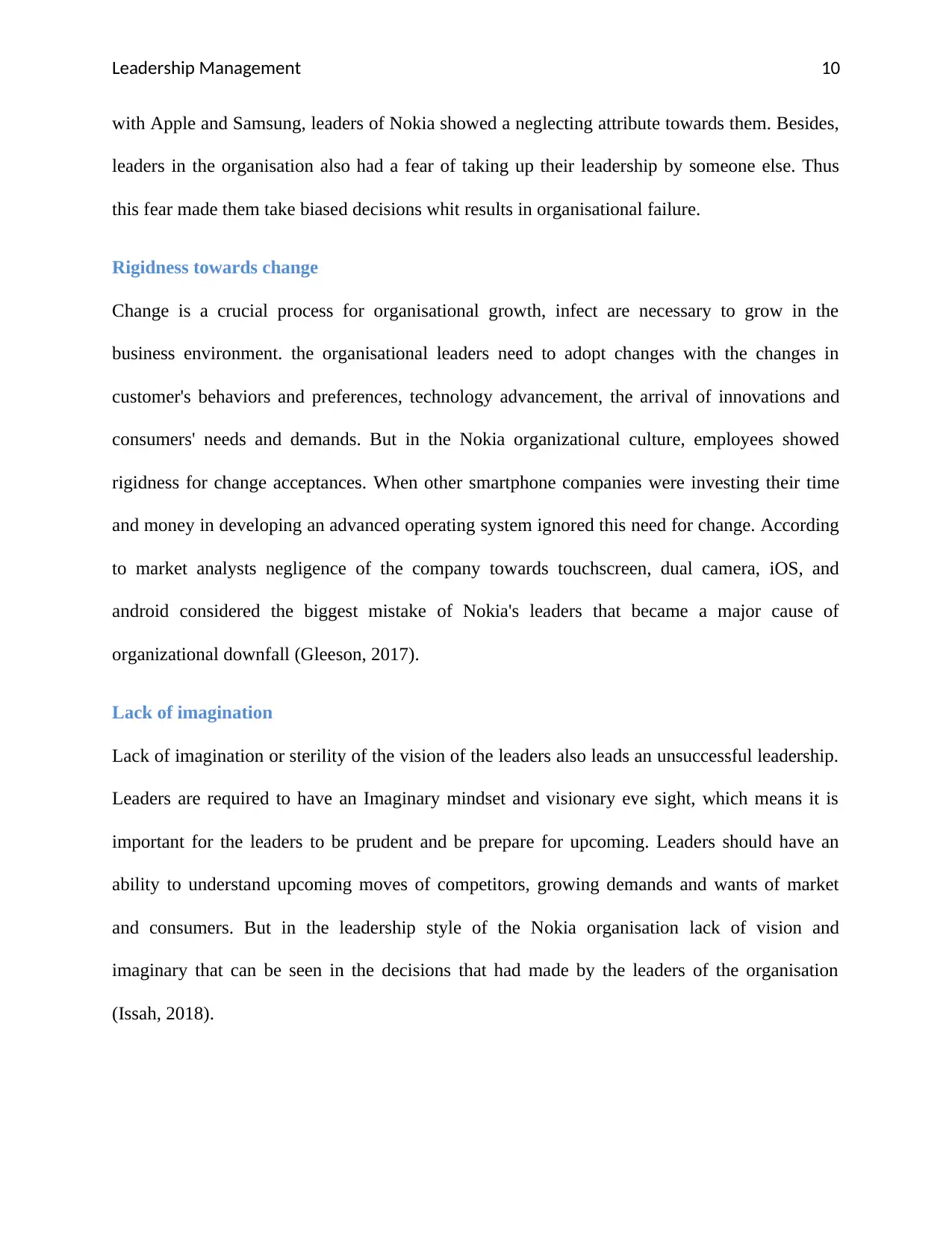
Leadership Management 10
with Apple and Samsung, leaders of Nokia showed a neglecting attribute towards them. Besides,
leaders in the organisation also had a fear of taking up their leadership by someone else. Thus
this fear made them take biased decisions whit results in organisational failure.
Rigidness towards change
Change is a crucial process for organisational growth, infect are necessary to grow in the
business environment. the organisational leaders need to adopt changes with the changes in
customer's behaviors and preferences, technology advancement, the arrival of innovations and
consumers' needs and demands. But in the Nokia organizational culture, employees showed
rigidness for change acceptances. When other smartphone companies were investing their time
and money in developing an advanced operating system ignored this need for change. According
to market analysts negligence of the company towards touchscreen, dual camera, iOS, and
android considered the biggest mistake of Nokia's leaders that became a major cause of
organizational downfall (Gleeson, 2017).
Lack of imagination
Lack of imagination or sterility of the vision of the leaders also leads an unsuccessful leadership.
Leaders are required to have an Imaginary mindset and visionary eve sight, which means it is
important for the leaders to be prudent and be prepare for upcoming. Leaders should have an
ability to understand upcoming moves of competitors, growing demands and wants of market
and consumers. But in the leadership style of the Nokia organisation lack of vision and
imaginary that can be seen in the decisions that had made by the leaders of the organisation
(Issah, 2018).
with Apple and Samsung, leaders of Nokia showed a neglecting attribute towards them. Besides,
leaders in the organisation also had a fear of taking up their leadership by someone else. Thus
this fear made them take biased decisions whit results in organisational failure.
Rigidness towards change
Change is a crucial process for organisational growth, infect are necessary to grow in the
business environment. the organisational leaders need to adopt changes with the changes in
customer's behaviors and preferences, technology advancement, the arrival of innovations and
consumers' needs and demands. But in the Nokia organizational culture, employees showed
rigidness for change acceptances. When other smartphone companies were investing their time
and money in developing an advanced operating system ignored this need for change. According
to market analysts negligence of the company towards touchscreen, dual camera, iOS, and
android considered the biggest mistake of Nokia's leaders that became a major cause of
organizational downfall (Gleeson, 2017).
Lack of imagination
Lack of imagination or sterility of the vision of the leaders also leads an unsuccessful leadership.
Leaders are required to have an Imaginary mindset and visionary eve sight, which means it is
important for the leaders to be prudent and be prepare for upcoming. Leaders should have an
ability to understand upcoming moves of competitors, growing demands and wants of market
and consumers. But in the leadership style of the Nokia organisation lack of vision and
imaginary that can be seen in the decisions that had made by the leaders of the organisation
(Issah, 2018).
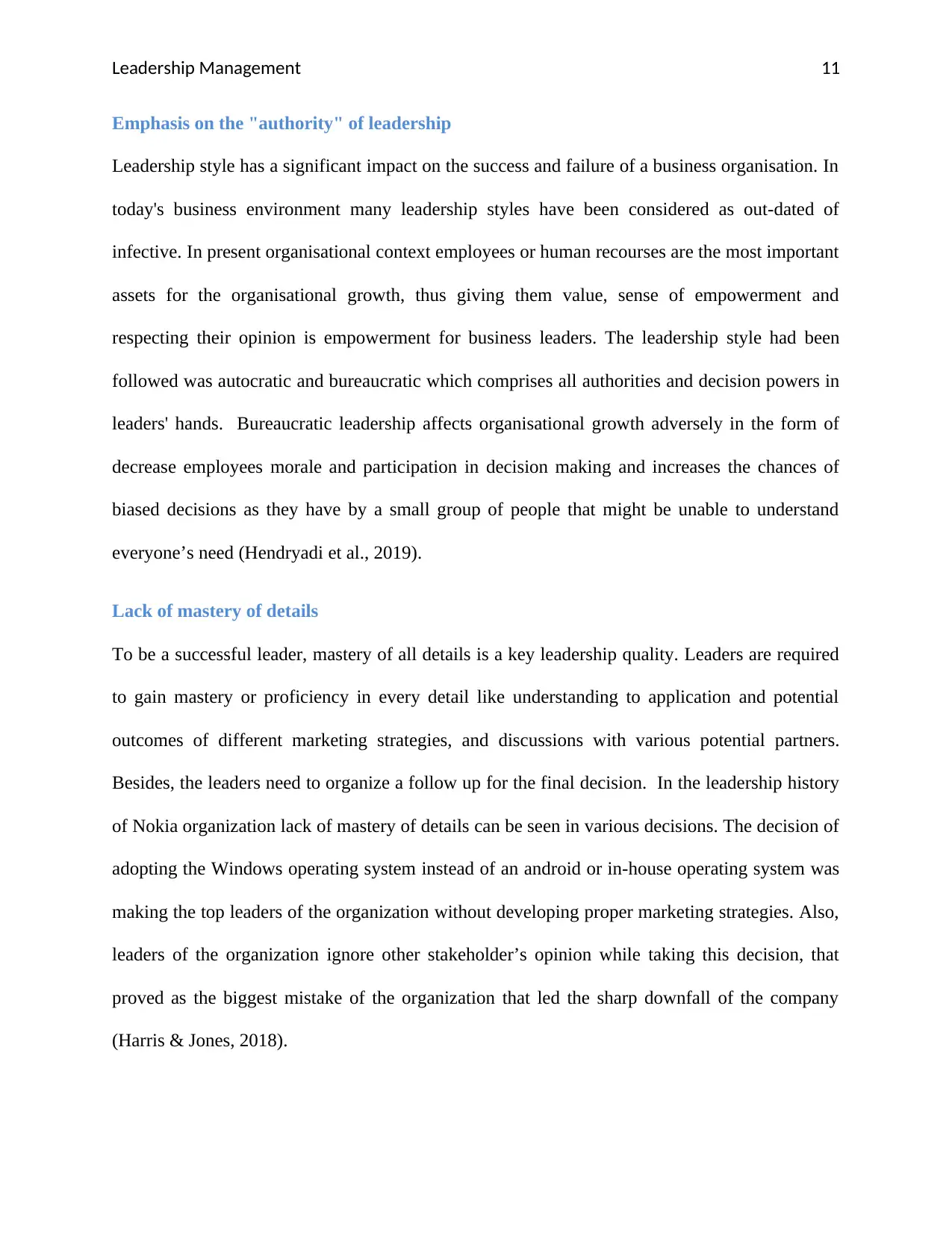
Leadership Management 11
Emphasis on the "authority" of leadership
Leadership style has a significant impact on the success and failure of a business organisation. In
today's business environment many leadership styles have been considered as out-dated of
infective. In present organisational context employees or human recourses are the most important
assets for the organisational growth, thus giving them value, sense of empowerment and
respecting their opinion is empowerment for business leaders. The leadership style had been
followed was autocratic and bureaucratic which comprises all authorities and decision powers in
leaders' hands. Bureaucratic leadership affects organisational growth adversely in the form of
decrease employees morale and participation in decision making and increases the chances of
biased decisions as they have by a small group of people that might be unable to understand
everyone’s need (Hendryadi et al., 2019).
Lack of mastery of details
To be a successful leader, mastery of all details is a key leadership quality. Leaders are required
to gain mastery or proficiency in every detail like understanding to application and potential
outcomes of different marketing strategies, and discussions with various potential partners.
Besides, the leaders need to organize a follow up for the final decision. In the leadership history
of Nokia organization lack of mastery of details can be seen in various decisions. The decision of
adopting the Windows operating system instead of an android or in-house operating system was
making the top leaders of the organization without developing proper marketing strategies. Also,
leaders of the organization ignore other stakeholder’s opinion while taking this decision, that
proved as the biggest mistake of the organization that led the sharp downfall of the company
(Harris & Jones, 2018).
Emphasis on the "authority" of leadership
Leadership style has a significant impact on the success and failure of a business organisation. In
today's business environment many leadership styles have been considered as out-dated of
infective. In present organisational context employees or human recourses are the most important
assets for the organisational growth, thus giving them value, sense of empowerment and
respecting their opinion is empowerment for business leaders. The leadership style had been
followed was autocratic and bureaucratic which comprises all authorities and decision powers in
leaders' hands. Bureaucratic leadership affects organisational growth adversely in the form of
decrease employees morale and participation in decision making and increases the chances of
biased decisions as they have by a small group of people that might be unable to understand
everyone’s need (Hendryadi et al., 2019).
Lack of mastery of details
To be a successful leader, mastery of all details is a key leadership quality. Leaders are required
to gain mastery or proficiency in every detail like understanding to application and potential
outcomes of different marketing strategies, and discussions with various potential partners.
Besides, the leaders need to organize a follow up for the final decision. In the leadership history
of Nokia organization lack of mastery of details can be seen in various decisions. The decision of
adopting the Windows operating system instead of an android or in-house operating system was
making the top leaders of the organization without developing proper marketing strategies. Also,
leaders of the organization ignore other stakeholder’s opinion while taking this decision, that
proved as the biggest mistake of the organization that led the sharp downfall of the company
(Harris & Jones, 2018).
⊘ This is a preview!⊘
Do you want full access?
Subscribe today to unlock all pages.

Trusted by 1+ million students worldwide
1 out of 22
Related Documents
Your All-in-One AI-Powered Toolkit for Academic Success.
+13062052269
info@desklib.com
Available 24*7 on WhatsApp / Email
![[object Object]](/_next/static/media/star-bottom.7253800d.svg)
Unlock your academic potential
Copyright © 2020–2025 A2Z Services. All Rights Reserved. Developed and managed by ZUCOL.





